
San Marino is located in Southern Europe, an enclave (landlocked) in central Italy, which it borders for 39 km. The third smallest independent state by area in Europe after the Vatican City and Monaco, San Marino is dominated by the Apennines. Located at 43.94°N 12.46°E, it covers an area of 61.2 km2 (23.6 sq mi). Completely mountainous, only 17% of its territory is arable. Several rivers flow through the country, the largest being the Ausa, the Marano, and the San Marino River.

Populus is a genus of 25–30 species of deciduous flowering plants in the family Salicaceae, native to most of the Northern Hemisphere. English names variously applied to different species include poplar, aspen, and cottonwood.

SPQR, an abbreviation for Senatus Populusque Romanus, is an emblematic abbreviated phrase referring to the government of the ancient Roman Republic. It appears on Roman currency, at the end of documents made public by an inscription in stone or metal, and in dedications of monuments and public and civil works.
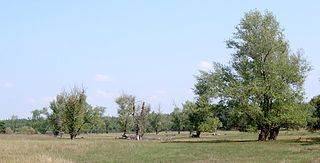
Populus nigra, the black poplar, is a species of cottonwood poplar, the type species of section Aigeiros of the genus Populus, native to Europe, southwest and central Asia, and northwest Africa.

The Gallaeci were a Celtic tribal complex who inhabited Gallaecia, the north-western corner of Iberia, a region roughly corresponding to what is now the Norte Region in northern Portugal, and the Spanish regions of Galicia, western Asturias and western León before and during the Roman period. They spoke a Q-Celtic language related to Northeastern Hispano-Celtic, called Gallaecian or Northwestern Hispano-Celtic. The region was annexed by the Romans in the time of Caesar Augustus during the Cantabrian Wars, a war which initiated the assimilation of the Gallaeci into Latin culture.

Populus tremuloides is a deciduous tree native to cooler areas of North America, one of several species referred to by the common name aspen. It is commonly called quaking aspen, trembling aspen, American aspen, mountain or golden aspen, trembling poplar, white poplar, and popple, as well as others. The trees have tall trunks, up to 25 meters tall, with smooth pale bark, scarred with black. The glossy green leaves, dull beneath, become golden to yellow, rarely red, in autumn. The species often propagates through its roots to form large clonal groves originating from a shared root system. These roots are not rhizomes, as new growth develops from adventitious buds on the parent root system.
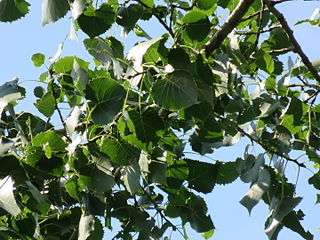
Populus deltoides, the eastern cottonwood or necklace poplar, is a cottonwood poplar native to North America, growing throughout the eastern, central, and southwestern United States as well as the southern Canadian prairies, the southernmost part of eastern Canada, and northeastern Mexico.
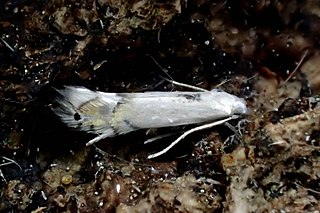
Phyllocnistis labyrinthella is a moth of the family Gracillariidae. It is found in most of continental Europe, except Italy, the Mediterranean Islands and parts of the Balkan Peninsula.
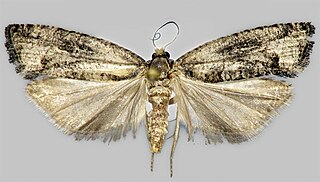
Epinotia maculana is a moth of the family Tortricidae. It is found in most of Europe, east to the eastern part of the Palearctic realm.

Epinotia nisella is a moth of the family Tortricidae which is found in the Palearctic, Europe and North America. It was first described be Carl Alexander Clerck in 1759.

Stigmella assimilella is a moth of the family Nepticulidae. It is found in most of Europe, east through Russia to the eastern part of the Palearctic realm.

Leucoptera sinuella is a moth in the Lyonetiidae family. It is found in most of Europe, except Ireland, the Balkan Peninsula and the Mediterranean Islands. It is also found in Japan and North Africa.

The aspen leaf blotch miner moth is a moth of the family Gracillariidae. It is found in most of Europe. It is also present in Turkey and North America.
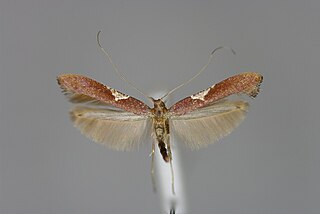
Caloptilia stigmatella is a moth of the family Gracillariidae. It is known from the Holarctic Region, including all of Europe.
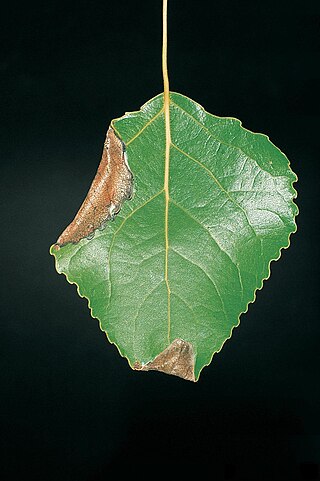
Ancylis laetana is a moth of the family Tortricidae. It is found in most of Europe, except the Iberian Peninsula, the Balkan Peninsula, Iceland, Ireland and Ukraine.

Aspen is a common name for certain tree species; some, but not all, are classified by botanists in the section Populus, of the Populus genus.
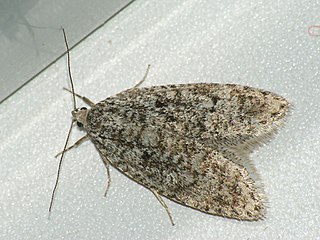
Semioscopis strigulana is a species of moth of the family Depressariidae. It is found in most of Europe east to the eastern parts of the Palearctic realm.

Sciota hostilis is a species of snout moth in the genus Sciota. It was described by Stephens in 1834. It is found in most of Europe.
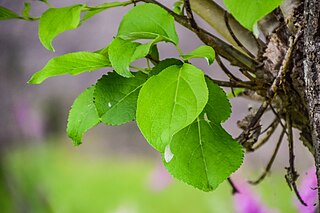
Populus suaveolens, called the Mongolian poplar, Korean poplar and Japanese poplar, is a species of flowering plant in the genus Populus, native to all of northern Asia, the Korean peninsula, the Kurils, and northern Japan. It is a tree reaching 30 m.

Te Rau Pūriri Regional Park is a regional park situated in the Auckland Region of New Zealand's North Island. It is owned and operated by Auckland Council.



















